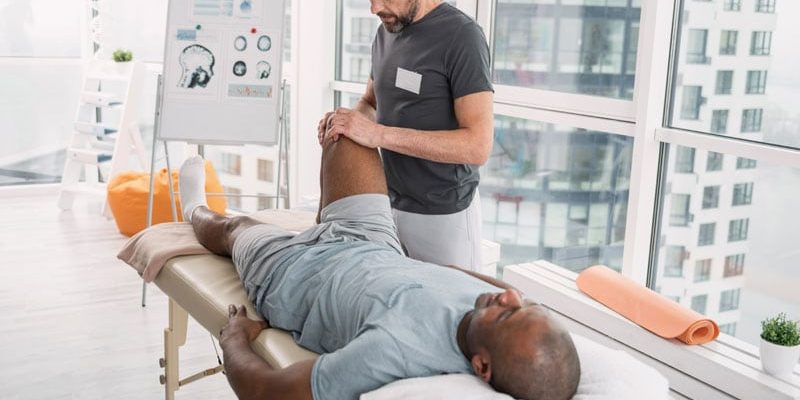Primary care physicians should consider referring patients with lower back pain (LBP) to physical therapists to avoid later high-cost and potentially unnecessary care.
A new study found that patients who were referred to physicial therapists within 2 weeks of seeing their physician for LBP were significantly less likely to make visits to a chiropractor, pain specialist, or orthopedist.
Patients also filed fewer claims for advanced imaging or epidural steroid injections and were half as likely to visit an emergency department (ED) within 30 days than those who did not start early physical therapy (PT), according to the study published July 3 in BMC Health Services Research.

Dr Richard Skolasky, Jr
“Some lower back pain resolves itself, but often, that recovery is incomplete, leading to increased healthcare and opioid use,” Richard Skolasky, Jr, ScD, director of the Spine Outcomes Research Center at Johns Hopkins Medicine, Baltimore, and a co-author of the study, said. “Our hope is this study helps more primary care physicians embrace nonpharmacologic, first-line treatments.”
LBP accounts for an estimated $1.8 billion annually in healthcare costs among the patients who do not receive surgery for the condition, according to a 2019 JAMA analysis of commercial insurance and Medicare claims. In addition, LBP accounts for approximately 2.7 million ED visits annually, a 2010 study published in Spine showed.
Skolasky and his colleagues assessed 980,000 outpatient claims over a period of almost 4 years that ended in 2014. The researchers used Truven MarketScan, a group of US-based administrative commercial healthcare insurance claims databases. Patients who had a history of conditions that cause LBP, such as endometriosis and spinal fracture, were excluded from the analysis. Approximately 11% of patients in the total sample received early PT, defined as PT received within 2 weeks of their initial visit to a primary care clinician.
After adjusting for sex, age, and Charlson Morbidity Index, patients who received PT were about half as likely as those who didn’t to see chiropractor or a pain specialist or have an ED visit within 30 days of their initial appointment. They were about one third as likely to receive an epidural steroid injection, and they were 43% less likely to have claims for advanced imaging, according to the researchers (P < .001 for all).
In addition, the cost of claims was lower for patients who received early PT ($747 vs $799), the researchers found.
The effects diminished somewhat over time but remained statistically significant.
At 1 year, patients who received early PT had slightly higher healthcare costs than those who didn’t undergo PT ($2588 vs $2510). Skolasky hypothesized that the increase was attributable to therapy visits and not having as many specialist visits. He said additional research could investigate whether early PT reduces the healthcare costs associated with LBP over a longer period.
“Physical therapy addresses a patient’s current pain and physical limitations and arms them with resources, exercises, and nonpharmacologic ways to deal with recurrences,” Skolasky told Medscape Medical News. “If we can follow patients even longer than a year, we may see a longer-term reduction in cost.”

Dr Michael Knight
Michael Knight, MD, MSHP, associate chief quality and population health officer at the George Washington University Medical Faculty Associates, Washington, DC, said he refers patients to physical therapists if their pain has not resolved within 2 weeks of stretching at home and taking over-the-counter analgesics.
Knight recalled one patient who had strained her back doing yard work. When home exercises did not help, Knight referred her to a physical therapist, who created a customized treatment plan. Within 4 weeks, her condition had improved.
“She was then able to take what she learned and continue those exercises at home,” Knight said. “She got better, and we avoided MRI costs for her and the healthcare system.”
Skolasky and his fellow researchers found significant regional differences in the number of patients referred for early PT. The odds of PT utilization within 90 days after the onset of LBP were 1.6 times higher in the Northeast and 0.82 times lower in the South.
“There are healthcare deserts,” Skolasky said. “This study should spark a conversation about the inadequacy of distribution of physical resources to meet the needs of patients with LBP.”
Skolasky said telehealth could be one option for serving patients in these healthcare deserts ― including those with LBP. He has conducted several studies that conclude that patients benefit from and are happy with telehealth PT.
Knight’s said Skolasky’s study will help patients better understand their options.
“Sometimes patients have an expectation ― they want an MRI or pain medication when it’s not necessary,” he said. “This kind of evidence helps strengthen our recommendation for early intervention that really can help.”
The study was supported by a grant from the National Institutes of Health’s National Institute on Aging. Skolasky reports no relevant financial relationships.
BMC Health Serv Res. Published online July 2, 2022. Full text
Kerrie Rushton is a freelance writer living in Maryland.
For more news, follow Medscape on Facebook, Twitter, Instagram, and YouTube.
Source: Read Full Article
